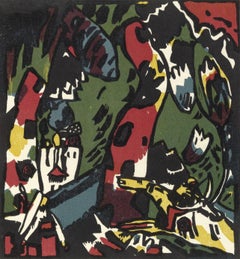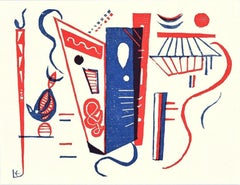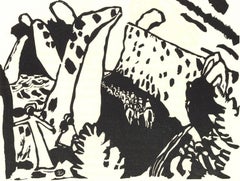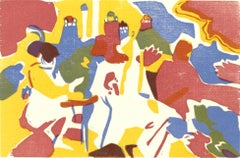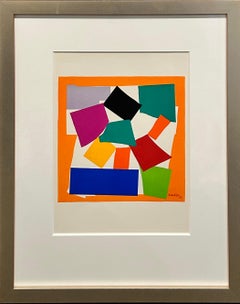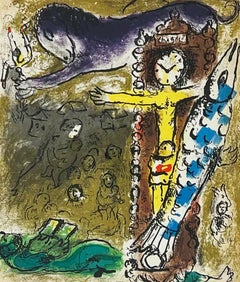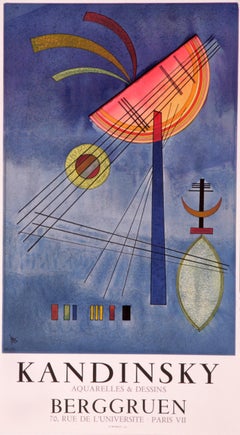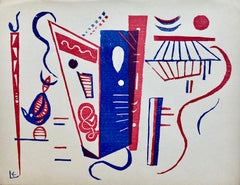Wassily Kandinsky Abstract Prints
“Color is a means of exerting a direct influence upon the soul,” wrote the pioneering abstract artist Wassily Kandinsky. The Russian-born painter and theorist dedicated his life to using abstract compositions of form and color to express deep emotion as well as to depict the language of music through visuals.
Kandinsky was part of a crucial moment in art history — the early 20th century — that saw the rise of movements like Cubism. He embraced styles such as Surrealism and Fauvism and was a leading figure in bringing together Der Blaue Reiter (the name means “The Blue Rider” after one of Kandinsky’s paintings) in 1911, a group of avant-garde artists in Munich, including Paul Klee and Franz Marc, who explored spiritual concepts through their art as a response to the materialism of the time. Kandinsky also led courses on analytical drawing and color at the Bauhaus. He was appointed by founder and architect Walter Gropius to teach in Weimar in 1922. He taught at all three of the legendary school’s locations and remained with the institution until its forced closure by the Nazi party in Berlin.
The artist had the rare and unusual trait of synesthesia, the neurological ability to perceive things using multiple senses. In Kandinsky’s case, it was the gift of “seeing” music, and music appeared in every aspect of his work, including the titles of his series “Compositions,” “Improvisations” and “Impressions.” He once described the experience of painting using a musical metaphor: “I had little thought for houses and trees, drawing colored lines and blobs on the canvas with my palette knife, and making them sing just as powerfully as I knew how.”
While Kandinsky isn’t the first abstract artist — mystically inclined painter Hilma af Klint was making nonrepresentational art well before him — he certainly had the biggest impact on establishing the style. His paintings inspired the likes of Jackson Pollock, Willem de Kooning and other Abstract Expressionists. From his Untitled (First Abstract Watercolor) painted in 1910 to future works, his unique take on using color and flair for bold, experimental compositions, Kandinsky is one of the most important figures of early-20th-century art.
Find original Wassily Kandinsky art, including paintings and prints, on 1stDibs.
1930s Modern Wassily Kandinsky Abstract Prints
Woodcut
1930s Modern Wassily Kandinsky Abstract Prints
Woodcut
1930s Modern Wassily Kandinsky Abstract Prints
Woodcut
1910s Post-Impressionist Wassily Kandinsky Abstract Prints
Lithograph
1930s Abstract Geometric Wassily Kandinsky Abstract Prints
Drypoint, Etching
1930s Modern Wassily Kandinsky Abstract Prints
Woodcut
1930s Modern Wassily Kandinsky Abstract Prints
Woodcut
1910s Blue Rider Wassily Kandinsky Abstract Prints
Woodcut
1970s Abstract Geometric Wassily Kandinsky Abstract Prints
Paper, Ink, Lithograph
1930s Modern Wassily Kandinsky Abstract Prints
Woodcut
1930s Modern Wassily Kandinsky Abstract Prints
Woodcut
1910s Blue Rider Wassily Kandinsky Abstract Prints
Woodcut, Laid Paper
1940s Modern Wassily Kandinsky Abstract Prints
Lithograph
1910s Abstract Wassily Kandinsky Abstract Prints
Drypoint
1970s Expressionist Wassily Kandinsky Abstract Prints
Woodcut
1950s Abstract Wassily Kandinsky Abstract Prints
Woodcut
1970s Modern Wassily Kandinsky Abstract Prints
Lithograph
1970s Abstract Wassily Kandinsky Abstract Prints
Color
1910s Blue Rider Wassily Kandinsky Abstract Prints
Woodcut
1910s Blue Rider Wassily Kandinsky Abstract Prints
Woodcut
1950s Fauvist Wassily Kandinsky Abstract Prints
Lithograph
1950s Fauvist Wassily Kandinsky Abstract Prints
Lithograph
Late 20th Century Post-Impressionist Wassily Kandinsky Abstract Prints
Screen
1950s Fauvist Wassily Kandinsky Abstract Prints
Lithograph
21st Century and Contemporary Contemporary Wassily Kandinsky Abstract Prints
Woodcut, Monoprint
1950s Fauvist Wassily Kandinsky Abstract Prints
Lithograph
1950s Post-Impressionist Wassily Kandinsky Abstract Prints
Lithograph
1970s Contemporary Wassily Kandinsky Abstract Prints
Woodcut
1980s Abstract Expressionist Wassily Kandinsky Abstract Prints
Drypoint, Etching, Aquatint, Intaglio
1970s Abstract Wassily Kandinsky Abstract Prints
Drypoint, Etching
21st Century and Contemporary Abstract Wassily Kandinsky Abstract Prints
Drypoint, Aquatint
2010s Contemporary Wassily Kandinsky Abstract Prints
Woodcut
1970s Modern Wassily Kandinsky Abstract Prints
Lithograph
1930s Abstract Wassily Kandinsky Abstract Prints
Woodcut
1930s Abstract Geometric Wassily Kandinsky Abstract Prints
Etching
1920s Contemporary Wassily Kandinsky Abstract Prints
Woodcut
1930s Abstract Wassily Kandinsky Abstract Prints
Woodcut
Wassily KandinskyComposition From "XXe Siècle" - Original Woodcut print by V. Kandinsky - 1939, 1939
1950s Abstract Wassily Kandinsky Abstract Prints
Lithograph
1950s Abstract Wassily Kandinsky Abstract Prints
Lithograph
1930s Abstract Wassily Kandinsky Abstract Prints
Drypoint, Etching
1970s Modern Wassily Kandinsky Abstract Prints
Lithograph
1960s Modern Wassily Kandinsky Abstract Prints
Lithograph
1930s Abstract Wassily Kandinsky Abstract Prints
Lithograph
1910s Abstract Wassily Kandinsky Abstract Prints
Woodcut
Wassily Kandinsky abstract prints for sale on 1stDibs.
Artists Similar to Wassily Kandinsky
- 1stDibs ExpertMarch 22, 2022Wassily Kandinsky's art is largely in the style of Expressionism. The movement began in the early 20th century and focused on conveying the emotional aspects of the subject. Expressionist paintings tend to feature bright colors and dramatic lines. Find a range of Wassily Kandinsky art on 1stDibs.
- 1stDibs ExpertAugust 20, 2024How much a Wassily Kandinsky painting is worth depends on its history, condition, size and other characteristics. In 2023, the artist's Murnau mit Kirche II sold for more than $44.7 million at an auction in London. Kandinsky used abstract compositions of form and color to express deep emotion as well as to depict the language of music through visuals. He was part of a crucial moment in art history that saw the rise of movements like Cubism. He was a leading figure in bringing together Der Blaue Reiter, a group of avant-garde artists who explored spiritual concepts through their art as a response to the materialism of the time. If you own a Kandinsky, seek the help of a certified appraiser or knowledgeable art dealer to determine how much your piece may be worth. Shop a collection of Wassily Kandinsky art on 1stDibs.
- 1stDibs ExpertNovember 26, 2024What Wassily Kandinsky's most famous painting is called is The Blue Rider or Der Blaue Reiter. The work inspired the name of a group of avant-garde artists in Munich, including Kandinsky, Paul Klee and Franz Marc, who explored spiritual concepts through their art as a response to the materialism of the time. Kandinsky created the painting in 1911, and today it is a part of a private collection. It depicts a figure in a blue cloak riding a white horse across a tree-lined landscape. Shop a variety of Wassily Kandinsky art on 1stDibs.
